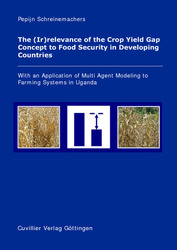| Departments | |
|---|---|
| Book Series (96) |
1378
|
| Nachhaltigkeit |
3
|
| Gesundheitswesen |
1
|
| Humanities |
2365
|
| Natural Sciences |
5406
|
| Mathematics | 229 |
| Informatics | 319 |
| Physics | 980 |
| Chemistry | 1363 |
| Geosciences | 131 |
| Human medicine | 243 |
| Stomatology | 10 |
| Veterinary medicine | 108 |
| Pharmacy | 147 |
| Biology | 835 |
| Biochemistry, molecular biology, gene technology | 121 |
| Biophysics | 25 |
| Domestic and nutritional science | 45 |
| Agricultural science | 1004 |
| Forest science | 201 |
| Horticultural science | 20 |
| Environmental research, ecology and landscape conservation | 148 |
| Engineering |
1793
|
| Common |
98
|
|
Leitlinien Unfallchirurgie
5. Auflage bestellen |
|
Advanced Search
The (Ir)relevance of the Crop Yield Gap Concept to Food Security in Developing Countries (English shop)
Pepijn Schreinemachers (Author)Preview
Table of Contents, Datei (43 KB)
Extract, Datei (61 KB)
The crop yield gap is defined as the difference between the yield potential and the
average yield of a crop, in which the yield potential is the maximum yield achieved
under optimal conditions with all stresses from nutrients, pests, and water
controlled. Pointing to an observed diminishing growth in global rice and wheat
yields, many studies have argued that the exploitable gap between potential and
average yields is too narrow and shrinking and that this endangers food security.
Such observations often lead to the claim that increasing the yield potential is the
best strategy we have to combat food insecurity and that the growth in yield
potential should at least keep pace with the growth in population to avert hunger.
| ISBN-13 (Printausgabe) | 3865379109 |
| ISBN-13 (Hard Copy) | 9783865379108 |
| ISBN-13 (eBook) | 9783736919105 |
| Language | German |
| Page Number | 230 |
| Edition | 1 |
| Volume | 0 |
| Publication Place | Göttingen |
| Publication Date | 2006-06-14 |
| General Categorization | Dissertation |
| Departments |
Environmental research, ecology and landscape conservation
|








